Frequency Properties of Polymer Bonded Compacts Obtained from Ball Milled Permalloy Powders with Mo and Cu Additions
Abstract
:1. Introduction
2. Materials and Methods
3. Results and Discussion
3.1. Mechanical Alloyed Powders
3.2. Polymerized Compacts
3.3. AC Magnetic Properties of the Composites
4. Conclusions
Author Contributions
Funding
Institutional Review Board Statement
Informed Consent Statement
Data Availability Statement
Conflicts of Interest
References
- Waeckerlé, T.; Demier, A.; Godard, F.; Fraisse, H. Evolution and Recent Developments of 80%Ni Permalloys. J. Magn. Magn. Mater. 2020, 505, 166635. [Google Scholar] [CrossRef]
- Couderchon, G.; Tiers, J.F. Some Aspects of Magnetic Properties of Ni-Fe and Co-Fe Alloys. J. Magn. Magn. Mater. 1982, 26, 196–214. [Google Scholar] [CrossRef]
- Bozorth, R.M. Ferromagnetism; D. Van Nostrand Company, INC.: Princeton, NJ, USA, 1951. [Google Scholar]
- Ali, M.; Ahmad, F. A Review of Processing Techniques for Fe-Ni Soft Magnetic Materials. Mater. Manuf. Process. 2019, 34, 1580–1604. [Google Scholar] [CrossRef]
- Nahrwold, G.; Scholtyssek, J.M.; Motl-Ziegler, S.; Albrecht, O.; Merkt, U.; Meier, G. Structural, Magnetic, and Transport Properties of Permalloy for Spintronic Experiments. J. Appl. Phys. 2010, 108, 13907. [Google Scholar] [CrossRef]
- Choi, J.G.; Hwang, D.G.; Rhee, J.R.; Lee, S.S. Comparison of the Soft Magnetic Properties of Permalloy and Conetic Thin Films. J. Magn. Magn. Mater. 2010, 322, 2191–2194. [Google Scholar] [CrossRef]
- Schönrath, H.; Spasova, M.; Kilian, S.O.; Meckenstock, R.; Witt, G.; Sehrt, J.T.; Farle, M. Additive Manufacturing of Soft Magnetic Permalloy from Fe and Ni Powders: Control of Magnetic Anisotropy. J. Magn. Magn. Mater. 2019, 478, 274–278. [Google Scholar] [CrossRef]
- Zhang, B.; Fenineche, N.E.; Zhu, L.; Liao, H.; Coddet, C. Studies of Magnetic Properties of Permalloy (Fe30%Ni) Prepared by SLM Technology. J. Magn. Magn. Mater. 2012, 324, 495–500. [Google Scholar] [CrossRef]
- Yatsugi, K.; Ishizaki, T.; Akedo, K.; Yamauchi, M. Composition-Controlled Synthesis of Solid-Solution Fe–Ni Nanoalloys and Their Application in Screen-Printed Magnetic Films. J. Nanopart. Res. 2019, 21, 60. [Google Scholar] [CrossRef]
- Haftlang, F.; Kim, E.S.; Kim, H.S. Crystallographic-Orientation-Dependent Magnetic Properties of Fe–Ni Permalloy in-Situ Alloyed Using Additive Manufacturing. J. Mater. Process. Technol. 2022, 309, 117733. [Google Scholar] [CrossRef]
- Mohamed, A.E.M.A.; Sheridan, R.S.; Bongs, K.; Attallah, M.M. Microstructure-Magnetic Shielding Development in Additively Manufactured Ni-Fe-Mo Soft Magnet Alloy in the as Fabricated and Post-Processed Conditions. J. Alloys Compd. 2021, 884, 161112. [Google Scholar] [CrossRef]
- Baco-Carles, V.; Baylac, V.; Pasquet, I.; Plissonneau, B.; Tailhades, P. Soft Chemistry Synthesis and Laser Powder Bed Fusion Processing of Fe–Ni Alloy Based Powders: A Route for the Manufacturing of Porous Multiphase Fe–Ni Alloy Parts. Powder Technol. 2022, 399, 18–25. [Google Scholar] [CrossRef]
- Septiani, E.L.; Kikkawa, J.; Cao, K.L.A.; Hirano, T.; Okuda, N.; Matsumoto, H.; Enokido, Y.; Ogi, T. Direct Synthesis of Submicron FeNi Particles via Spray Pyrolysis Using Various Reduction Agents. Adv. Powder Technol. 2021, 32, 4263–4272. [Google Scholar] [CrossRef]
- Neamţu, B.V.; Chicinaș, I.; Isnard, O.; Popa, F.; Pop, V. Influence of Wet Milling Conditions on the Structural and Magnetic Properties of Ni3Fe Nanocrystalline Intermetallic Compound. Intermetallics 2011, 19, 19–25. [Google Scholar] [CrossRef]
- Popa, F.; Isnard, O.; Chicinaş, I.; Pop, V. Synthesis of Nanocrystalline Supermalloy Powders by Mechanical Alloying: A Thermomagnetic Analysis. J. Magn. Magn. Mater. 2010, 322, 1548–1551. [Google Scholar] [CrossRef]
- Popa, F.; Isnard, O.; Chicinas, I.; Pop, V. NiFeCuMo Magnetic Powders Obtained by Controlled Mechanical Alloying and Annealing. J. Magn. Magn. Mater. 2007, 316, e900–e903. [Google Scholar] [CrossRef]
- Pop, V.; Isnard, O.; Chicinaş, I. Crystallographic and Magnetic Study of the Nanocrystalline Ni3Fe Intermetallic Compound Formation by Mechanical Alloying and Annealing. J. Alloys Compd. 2003, 361, 144–152. [Google Scholar] [CrossRef]
- Chinnasamy, C.N.; Narayanasamy, A.; Ponpandian, N.; Chattopadhyay, K.; Saravanakumar, M. Order-Disorder Studies and Magnetic Properties of Mechanically Alloyed Nanocrystalline Ni3Fe Alloy. Mater. Sci. Eng. A 2001, 304, 408–412. [Google Scholar] [CrossRef]
- Volk, M.W.R.; Wack, M.R.; Maier, B.J. Monitoring the Alloying Process of Mechanically Synthesized Fe80Ni20 through Changes in Magnetic Properties. J. Alloys Compd. 2018, 732, 336–342. [Google Scholar] [CrossRef]
- Tjong, S.C.; Chen, H. Nanocrystalline Materials and Coatings. Mater. Sci. Eng. R Reports 2004, 45, 1–88. [Google Scholar] [CrossRef]
- Suryanarayana, C. Mechanical Alloying and Milling. Prog. Mater. Sci. 2001, 46, 1–184. [Google Scholar] [CrossRef]
- Gaffet, E.; Le Caer, G. Mechanical Processing for Nanomaterials. In Encyclopedia of Nanoscience and Nanotechnology; Nalwa, H.S., Ed.; American Scientific Publishers: Valencia, CA, USA, 2004; Volume X, pp. 1–39. ISBN 1588830012. [Google Scholar]
- Herzer, G. Soft Magnetic Nanocrystalline Materials. Scr. Metall. Mater. 1995, 33, 1741–1756. [Google Scholar] [CrossRef]
- Kaloshkin, S.D.; Tcherdyntsev, V.V.; Baldokhin, Y.V.; Tomilin, I.A.; Shelekhov, E.V. Mechanically Alloyed Low-Nickel Austenite Fe-Ni Phase: Evidence of Single-Phase Paramagnetic State. J. Non-Cryst. Solids 2001, 287, 329–333. [Google Scholar] [CrossRef]
- Hamzaoui, R.; Elkedim, O.; Gaffet, E. Milling Conditions Effect on Structure and Magnetic Properties of Mechanically Alloyed Fe-10% Ni and Fe-20% Ni Alloys. Mater. Sci. Eng. A 2004, 381, 363–371. [Google Scholar] [CrossRef]
- Djekoun, A.; Bouzabata, B.; Otmani, A.; Greneche, J.M. X-Ray Diffraction and Mössbauer Studies of Nanocrystalline Fe-Ni Alloys Prepared by Mechanical Alloying. Catal. Today 2004, 89, 319–323. [Google Scholar] [CrossRef]
- Popa, F.; Isnard, O.; Chicinaş, I.; Pop, V. Thermal Evolution of the Ni3Fe Compound Obtained by Mechanical Alloying as Probed by Differential Scanning Calorimetry. J. Alloys Compd. 2013, 554, 39–44. [Google Scholar] [CrossRef]
- Chicinas, I.; Geoffroy, O.; Isnard, O.; Pop, V. Soft Magnetic Composite Based on Mechanically Alloyed Nanocrystalline Ni3Fe Phase. J. Magn. Magn. Mater. 2005, 290, 1531–1534. [Google Scholar] [CrossRef]
- Olekšáková, D.; Füzer, J.; Kollár, P.; Švec, T.; Kováč, J.; Briančin, J.; Polański, K. Structure and Magnetic Properties of Powder Permalloy Fe-Ni. Czechoslov. J. Phys. 2004, 54, 12–15. [Google Scholar] [CrossRef]
- Prică, C.V.; Neamţu, B.V.; Popa, F.; Marinca, T.F.; Sechel, N.; Chicinaş, I. Invar-Type Nanocrystalline Compacts Obtained by Spark Plasma Sintering from Mechanically Alloyed Powders. J. Mater. Sci. 2018, 53, 3735–3743. [Google Scholar] [CrossRef]
- Ghosh, N.C.; Das, H.N.; Gafur, M.A.; Akther Hossain, A.K.M. Formation and Magnetic Properties of Nanocrystalline 78.5-Permalloy by Mechanical Alloying. Procedia Eng. 2014, 90, 136–139. [Google Scholar] [CrossRef]
- Chicinaş, I.; Pop, V.; Isnard, O.; Le Breton, J.M.; Juraszek, J. Synthesis and Magnetic Properties of Ni3Fe Intermetallic Compound Obtained by Mechanical Alloying. J. Alloys Compd. 2003, 352, 34–40. [Google Scholar] [CrossRef]
- Chicinas, I.; Pop, V.; Isnard, O. Synthesis of the Supermalloy Powders by Mechanical Alloying. J. Mater. Sci. 2004, 39, 5305–5309. [Google Scholar] [CrossRef]
- Olekšáková, D.; Kollár, P.; Füzer, J. Structure and Magnetic Properties of Powdered and Compacted FeNi Alloys. J. Electr. Eng. 2017, 68, 163–166. [Google Scholar] [CrossRef]
- Shokrollahi, H.; Janghorban, K. Soft Magnetic Composite Materials (SMCs). J. Mater. Process. Technol. 2007, 189, 1–12. [Google Scholar] [CrossRef]
- Périgo, E.A.; Weidenfeller, B.; Kollár, P.; Füzer, J. Past, Present, and Future of Soft Magnetic Composites. Appl. Phys. Rev. 2018, 5, 031301. [Google Scholar] [CrossRef]
- Inoue, A.; Kong, F. Soft Magnetic Materials. Encycl. Smart Mater. 2021, 5, 10–23. [Google Scholar] [CrossRef]
- Pop, V.; Isnard, O.; Chicinaş, I.; Givord, D. Magnetic and Structural Properties of SmCo5/α-Fe Nanocomposites. J. Magn. Magn. Mater. 2007, 310, 2489–2490. [Google Scholar] [CrossRef]
- Neamţu, B.V.; Geoffroy, O.; Chicinaş, I.; Isnard, O. AC Magnetic Properties of the Soft Magnetic Composites Based on Supermalloy Nanocrystalline Powder Prepared by Mechanical Alloying. Mater. Sci. Eng. B Solid-State Mater. Adv. Technol. 2012, 177, 661–665. [Google Scholar] [CrossRef]
- Varga, L.K. Soft Magnetic Nanocomposites for High-Frequency and High-Temperature Applications. J. Magn. Magn. Mater. 2007, 316, 442–447. [Google Scholar] [CrossRef]
- Li, W.; Li, J.; Peng, X.; Xu, J.; Yang, Y.; Jin, D.; Jin, H.; Wang, X.; Ge, H. Improved Permeability and Decreased Core Loss of Iron-Based Soft Magnetic Composites with Yig Ferrite Insulating Layer. SSRN Electron. J. 2022, 937, 168285. [Google Scholar] [CrossRef]
- Marinca, T.F.; Popa, F.; Neamțu, B.V.; Prică, V.C.; Chicinaș, I. Permalloy/Alumina Soft Magnetic Composite Compacts Obtained by Reaction of Al-Permalloy with Fe2O3 Nanoparticles upon Spark Plasma Sintering. Ceram. Int. 2022, 49, 2272–2281. [Google Scholar] [CrossRef]
- Zhao, R.; Huang, J.; Yang, Y.; Jiao, L.; Dong, Y.; Liu, X.; Liu, Z.; Wu, S.; Li, X.; He, A.; et al. The Influence of FeNi Nanoparticles on the Microstructures and Soft Magnetic Properties of FeSi Soft Magnetic Composites. Adv. Powder Technol. 2022, 33, 103663. [Google Scholar] [CrossRef]
- Langford, J.I. The Use of the Voigt Function in Determining Microstructural Properties from Diffraction Data by Means of Pattern Decomposition. In Proceedings of the International Conference. Accuracy in Powder Diffraction II, Gaitherburg, MD, USA, 26–29 May 1992; pp. 110–126. [Google Scholar]
- Vives, S.; Gaffet, E.; Meunier, C. X-ray Diffraction Line Profile Analysis of Iron Ball Milled Powders. Mater. Sci. Eng. A 2004, 366, 229–238. [Google Scholar] [CrossRef]
- Rodríguez-Carvajal, J. Recent Advances in Magnetic Structure Determination by Neutron Powder Diffraction. Phys. B Phys. Condens. Matter 1993, 192, 55–69. [Google Scholar] [CrossRef]
- ImageJ Software. Available online: https://imagej.nih.gov/ij/ (accessed on 3 October 2022).
- Karimi, L.; Shokrollahi, H.; Karimi, Z.; Mohammadi, M. Improvement of Magnetic Properties of Nanostructured Ni79Fe16Mo5 Alloyed Powders by a Suitable Heat Treatment. Adv. Powder Technol. 2013, 24, 653–658. [Google Scholar] [CrossRef]
- Gupta, K.; Raina, K.K.; Sinha, S.K. Influence of Process Parameters and Alloy Composition on Structural, Magnetic and Electrical Characteristics of Ni-Fe Permalloys. J. Alloys Compd. 2007, 429, 357–364. [Google Scholar] [CrossRef]
- Available online: http://www.goodfellow.com/ (accessed on 3 October 2022).
- Kollár, P.; Olekšáková, D.; Füzer, J.; Kováč, J.; Roth, S.; Polański, K. The Magnetic Properties of Powdered and Compacted Microcrystalline Permalloy. J. Magn. Magn. Mater. 2007, 310, 2609–2611. [Google Scholar] [CrossRef]
- De La Barrière, O.; Appino, C.; Fiorillo, F.; Ragusa, C.; Ahmed, H.B.; Gabsi, M.; Mazaleyrat, F.; Lobue, M. Loss Separation in Soft Magnetic Composites. J. Appl. Phys. 2011, 109, 07A317. [Google Scholar] [CrossRef] [Green Version]
- Kollár, P.; Birčáková, Z.; Füzer, J.; Bureš, R.; Fáberová, M. Power Loss Separation in Fe-Based Composite Materials. J. Magn. Magn. Mater. 2013, 327, 146–150. [Google Scholar] [CrossRef]
- Zhang, Z.; Xu, W.; Guo, T.; Jiang, Y.; Yan, M. Effect of Processing Parameters on the Magnetic Properties and Microstructures of Molybdenum Permalloy Compacts Made by Powder Metallurgy. J. Alloys Compd. 2014, 594, 153–157. [Google Scholar] [CrossRef]
- Qin, G.W.; Pei, W.L.; Ren, Y.P.; Shimada, Y.; Endo, Y.; Yamaguchi, M.; Okamoto, S.; Kitakami, O. Ni80Fe20 Permalloy Nanoparticles: Wet Chemical Preparation, Size Control and Their Dynamic Permeability Characteristics When Composited with Fe Micron Particles. J. Magn. Magn. Mater. 2009, 321, 4057–4062. [Google Scholar] [CrossRef]
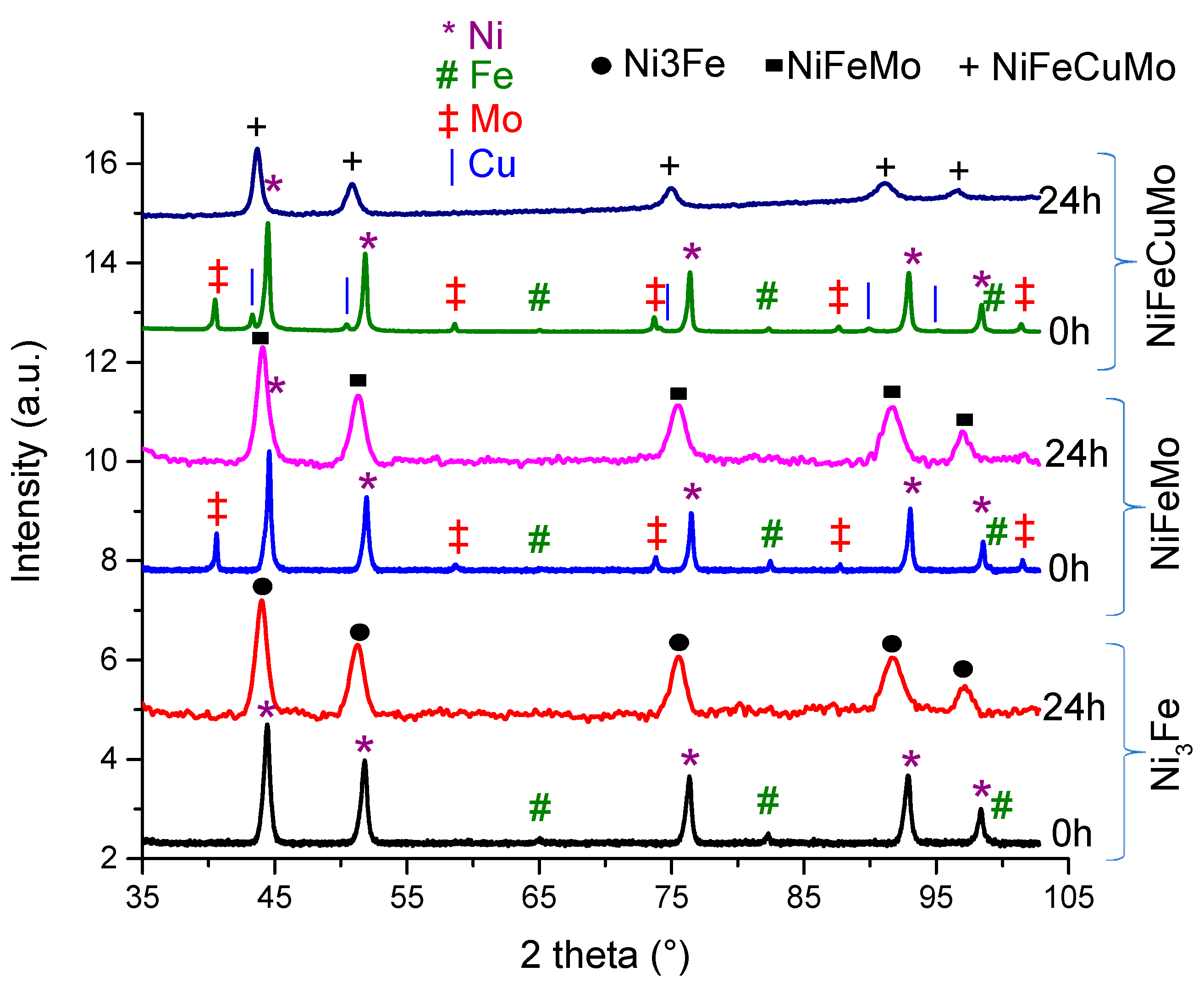
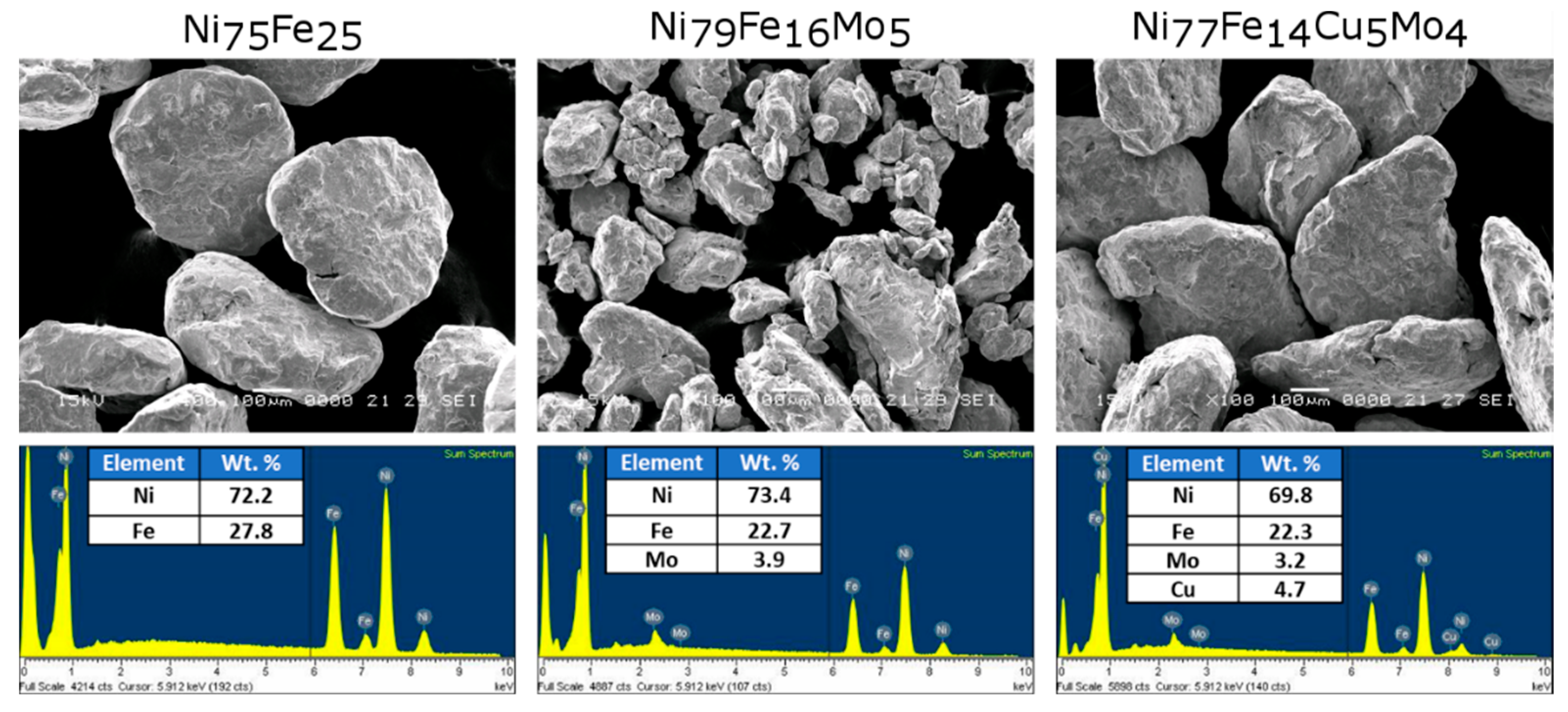
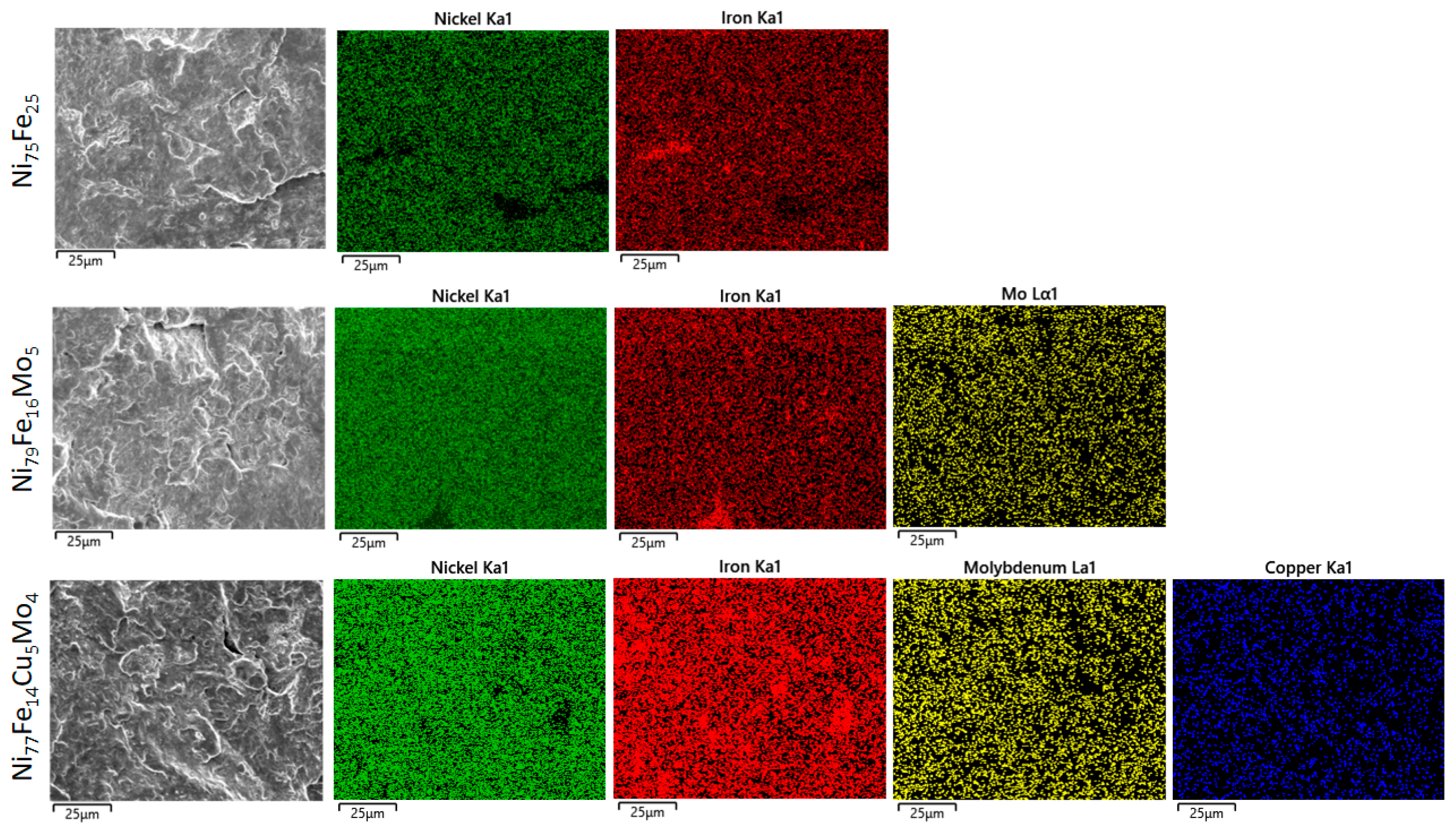
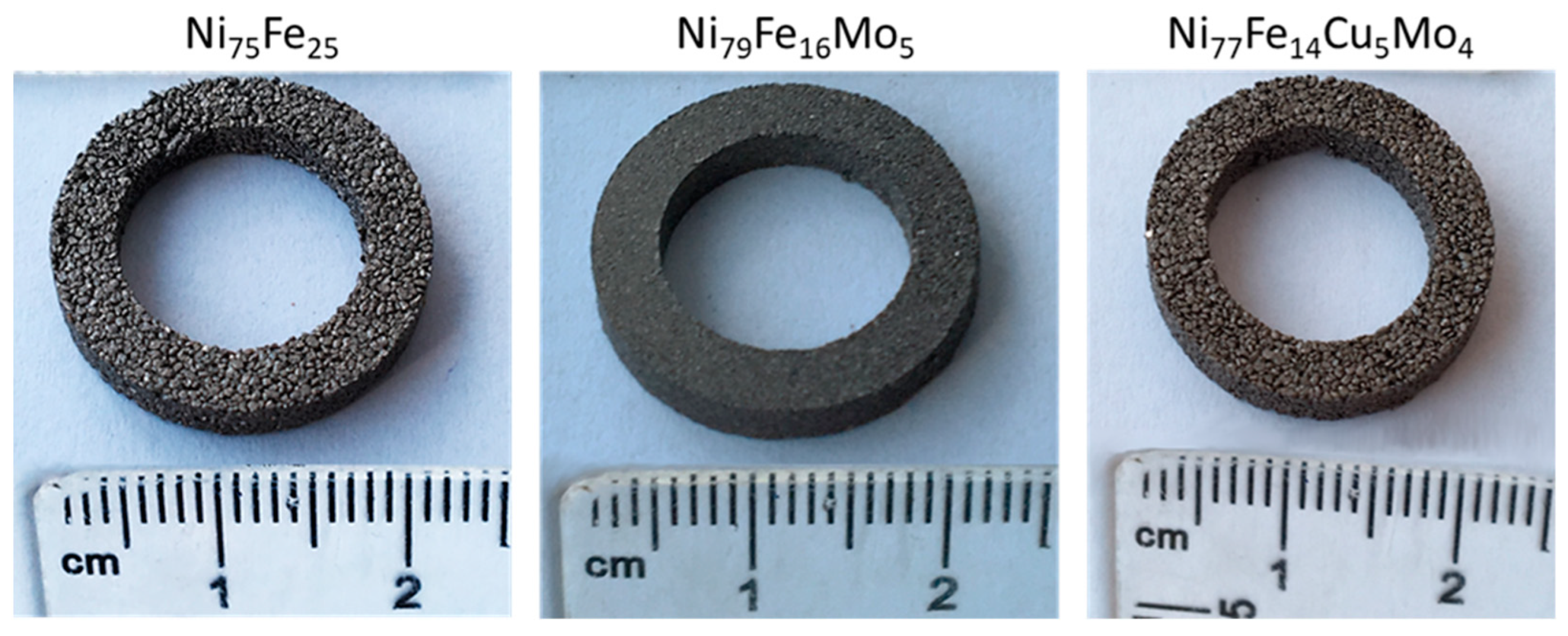

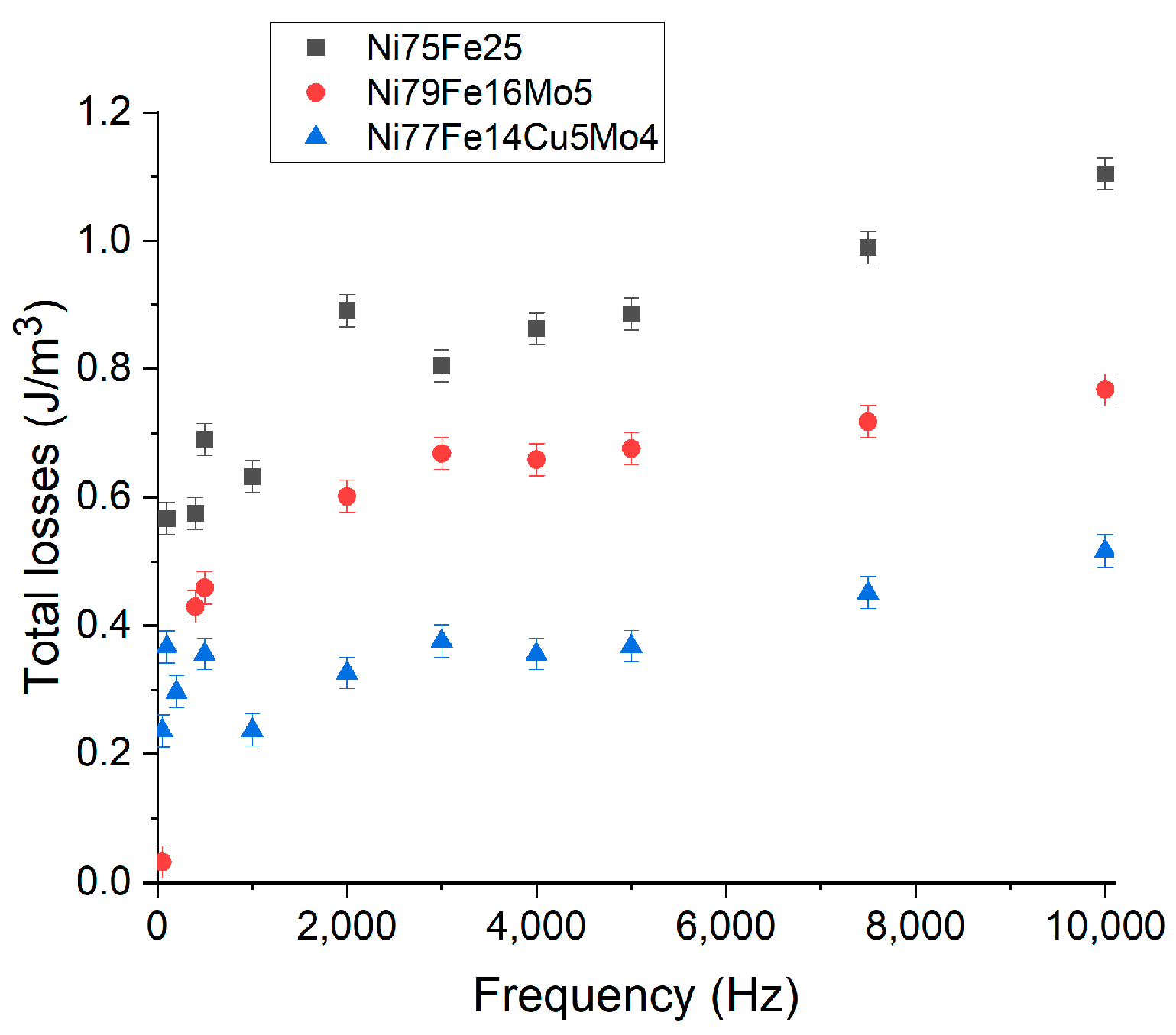
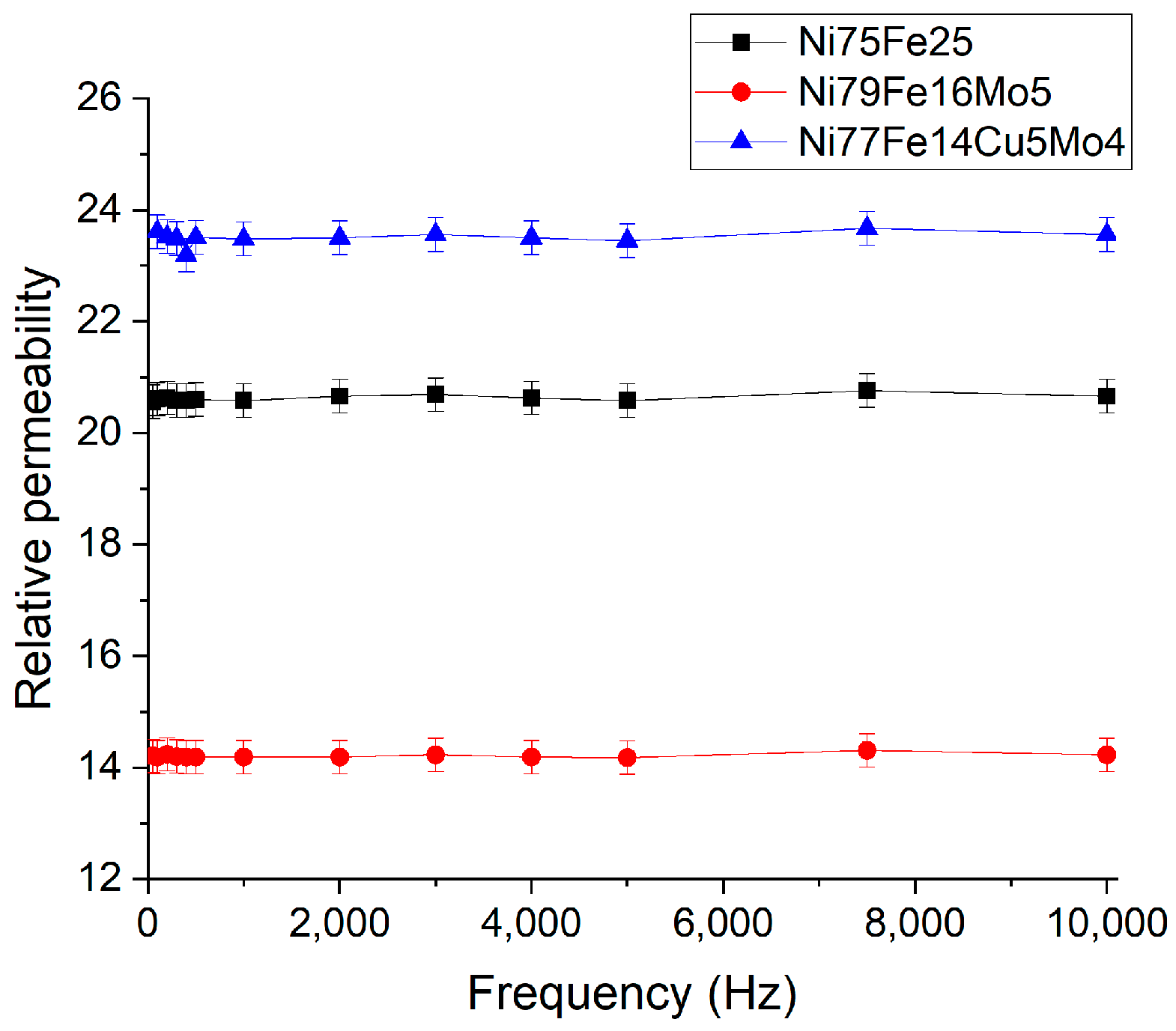

| Material [Milled 24 h] | Mean Crystallite Size [nm] | Lattice Strain [%] |
|---|---|---|
| Ni75Fe25 | 19 | 0.015 |
| Ni79Fe16Mo5 | 10 | 0.013 |
| Ni77Fe14Cu5Mo4 | 62 | 0.041 |
| Material | Density [g/cm3] | Electrical Resistivity [Ω·m] |
|---|---|---|
| Ni75Fe25 (composite compacts) | 5.73 | 1.5 × 10−3 |
| Ni79Fe16Mo5 (composite compacts) | 5.74 | 2.5 × 10−3 |
| Ni77Fe14Cu5Mo4 (composite compacts) | 5.94 | 7.3 × 10−3 |
| Ni75Fe25 (cast) | 8.55 [3] | 1.6 × 10−7 [3] |
| Ni79Fe16Mo5 (cast) | 8.75 [3] | 6.0 × 10−7 [50] |
| Ni77Fe14Cu5Mo4 (cast) | 8.80 [50] | 5.8 × 10−7 [50] |
| Ni [50] | 8.90 | 6.9 × 10−8 |
| Fe [50] | 7.87 | 1.0 × 10−7 |
| Cu [50] | 8.96 | 1.7 × 10−8 |
| Mo [50] | 10.22 | 5.7 × 10−8 |
| Material | Induction @ 9 kA/m [T] | Coercive Field [A/m] |
|---|---|---|
| Ni75Fe25 | 0.23 | 285 |
| Ni79Fe16Mo5 | 0.16 | 135 |
| Ni77Fe14Cu5Mo4 | 0.22 | 184 |
Disclaimer/Publisher’s Note: The statements, opinions and data contained in all publications are solely those of the individual author(s) and contributor(s) and not of MDPI and/or the editor(s). MDPI and/or the editor(s) disclaim responsibility for any injury to people or property resulting from any ideas, methods, instructions or products referred to in the content. |
© 2023 by the authors. Licensee MDPI, Basel, Switzerland. This article is an open access article distributed under the terms and conditions of the Creative Commons Attribution (CC BY) license (https://creativecommons.org/licenses/by/4.0/).
Share and Cite
Popa, F.; Isnard, O.; Neamțu, B.V.; Chicinaș, I. Frequency Properties of Polymer Bonded Compacts Obtained from Ball Milled Permalloy Powders with Mo and Cu Additions. Materials 2023, 16, 592. https://doi.org/10.3390/ma16020592
Popa F, Isnard O, Neamțu BV, Chicinaș I. Frequency Properties of Polymer Bonded Compacts Obtained from Ball Milled Permalloy Powders with Mo and Cu Additions. Materials. 2023; 16(2):592. https://doi.org/10.3390/ma16020592
Chicago/Turabian StylePopa, Florin, Olivier Isnard, Bogdan Viorel Neamțu, and Ionel Chicinaș. 2023. "Frequency Properties of Polymer Bonded Compacts Obtained from Ball Milled Permalloy Powders with Mo and Cu Additions" Materials 16, no. 2: 592. https://doi.org/10.3390/ma16020592






